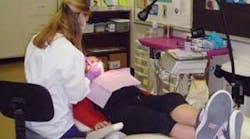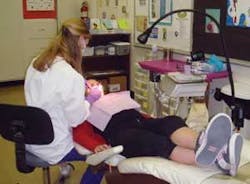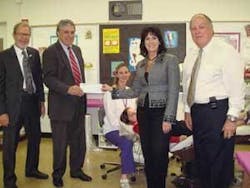by Christine Nathe, RDH, MS
I had quite a few e-mails after the column I wrote on school-based dental hygiene clinics. It seems many dental hygienists are excited to try this avenue and that quite a few needed more information about starting up a clinic in their local school system. Specifically, many wanted information about funding and finances.
The best way to address funding for school-based clinics, in my opinion, is for dental hygiene to collaborate and partner with other organizations and disciplines. We often feel like we are alone, and that oral health is left out too many times in health care. One way to make sure that we are not left out is to branch out and work with others who share the same objectives.
I know it can be difficult for a dental hygienist to be a self-sustaining provider in a school. If the school is affluent, many of the students may have a regular dental office where they receive routine preventive care already. In a lower-income school, some students may be covered by Medicaid dental insurance that may not have comparable UCR rates, or they may not be covered by any insurance at all, which can affect reimbursement.
The first step is to find out how the school funds the school nurse or other school-based health providers. There may be ways that the state or local government could fund the dental hygiene position, so that the reimbursement for services rendered could help fund equipment and supplies. As dental hygienists, we often feel the need to produce to fund our position, without seeking other funding options as other health-care providers do. I know. I learned this quite well while working in a nursing home in a salaried position. Imagine my surprise when I realized that they were not even billing for the services I rendered. I was being paid because they had a dental hygiene position within their operating budget. After all, I am a dental hygienist, and it was hard for me to imagine not making my salary and then some by providing clinical services.
At the University of New Mexico, we partnered with Delta Dental of New Mexico. Although New Mexican school children receive dental care via mobile dental programs throughout the state, UNM initiated the first school-based permanent dental clinic with the help of Delta Dental of New Mexico in a middle school. Although we bill Medicaid and private dental insurance when the students are insured, we still needed help to cover the costs of the clinic.
Currently, the Van Buren Middle School program provides preventive service in a coordinated effort with the nearby UNM Southeast Heights Dental Clinic to provide restorative services while simultaneously exposing UNM dental hygiene students to practicing in a school-based clinic. The Van Buren SBHC dental program provides students with dental cleanings, fluoride treatments, sealants, individualized and classroom oral health education, dental exams, and referrals for needed treatment. The dental hygienist works with parents, teachers, and dentists to ensure optimal dental health for all students. This endeavor is an excellent way to showcase the success of collaboration!
About the Author
Christine Nathe, RDH, MS, is a professor and graduate program director at the University of New Mexico, Division of Dental Hygiene, in Albuquerque, N.M. She is also the author of “Dental Public Health” (www.prenhall.com/nathe), which is in its second edition with Prentice Hall. She can be reached at [email protected] or (505) 272-8147.








